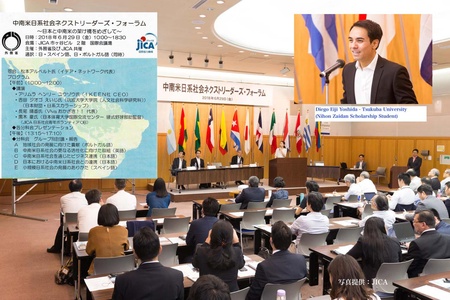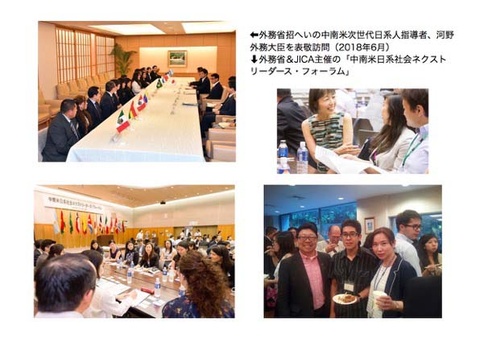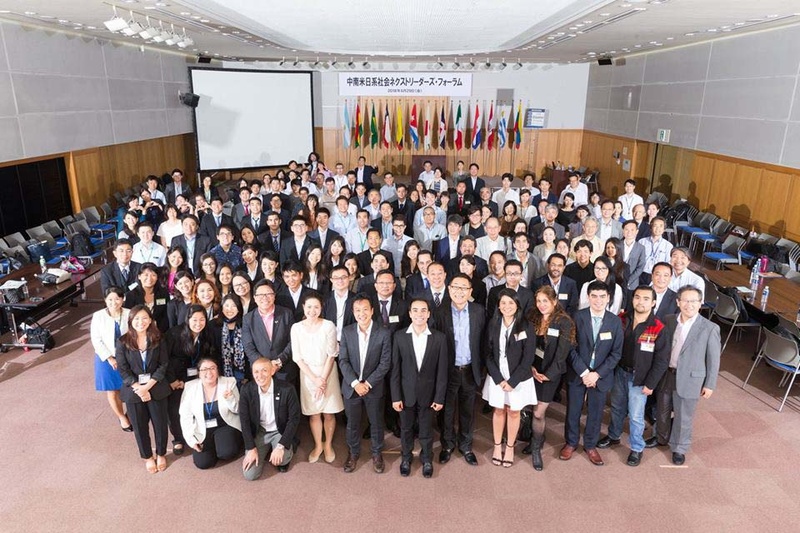For the past few years, the Japanese Ministry of Foreign Affairs has been inviting the next generation of Japanese leaders from Latin America. I have been involved in this project for the past six years at the request of the Ministry of Foreign Affairs' Latin America and Caribbean Affairs Bureau. Despite the tight schedule, the invited Japanese people have the opportunity to meet with relevant organizations and sometimes even the Prime Minister. This is because the Japanese government hopes that they will become future leaders of the Japanese community and act as a bridge between the country and Japan. I have always felt that the Japanese government wants to further strengthen and shape the network with Japanese people overseas.
In June 2018, the Ministry of Foreign Affairs invited 15 next-generation Nikkei leaders to Japan.1 They participated in and exchanged views at a special event held at the International Conference Hall of the JICA Ichigaya Building, co-hosted by the Ministry of Foreign Affairs and JICA, called the Forum for Next Leaders of Nikkei Communities in Latin America: Building a Bridge between Japan and Latin America.2 The forum was also attended by representatives of organizations supporting Nikkei students and people of Japanese descent in Japan, as well as the children of Nikkei workers currently enrolled or graduating from university.
Lectures were given in the morning, and various breakout sessions were held in the afternoon. Discussions were led by invitees and international students, and were conducted in English, Portuguese, Spanish, and Japanese. As the moderator of the forum, I periodically visited each table to ensure that the discussion did not go off track, and occasionally provided hints and examples to deepen the discussion. JICA and Ministry of Foreign Affairs staff and participants from related organizations offered opinions based on different perspectives, approaches, and abundant experience.

The priority issues for Japanese communities differ in each country, and it was felt that it would be difficult to reach a consensus even in a neighboring region. It is extremely difficult to compare the situation of the Japanese community of tens of thousands, or even hundreds of thousands, living in the city of São Paulo and its suburbs with the situation in the postwar settlements in Bolivia and Paraguay. In addition, the ways of contributing to the development of local communities differ between urban and rural areas, so the approaches to revitalizing Japanese communities are naturally different. The gap in awareness between generations and management problems in countries with large existing organizations, such as Japanese associations and prefectural associations, were also pointed out.
A common thread in each country was the dramatic increase in the number of local non-Japanese participants in Japanese cultural events, which became a major source of income for the Japanese community. However, some Japanese argued that this was also hindering change and improvement. The reasons cited included that the organization was too complicated and bureaucratic, there were too many groups, and the high maintenance costs. The younger generation uses social media to organize events by event or interest, and organizes them, calculating the various expenses for each event and predicting income. They volunteer, but they do not organize events using their own pocket money or donations like the older generation did. Not all events are held in Japanese community facilities, and in some cases, they are often held at city, state, or local schools and universities.
There was also discussion of "small-scale Japanese communities" consisting of several dozen households, which exist in many regional cities in Brazil, where there are an estimated 1.8 million Japanese people. These are Japanese communities that are not closely connected to major cities or the capital. They can be found in northern Argentina and Patagonia, the Amazon depths of Peru and Bolivia, and in Chile, Uruguay, Colombia, Venezuela, and other countries where there are generally few Japanese people. Japanese communities in the Dominican Republic and Cuba in the Caribbean, as well as Mexican Japanese communities outside of Mexico City (the capital) and Guadalajara, can also be considered small communities. Of course, there are areas where Japanese people live, but they are completely part of the local society, there are no Japanese organizations or Japanese language schools, and nothing that could be called a "Japanese community" has developed.
Even though these communities may be "small-scale," many of them are able to blend into the local society and contribute with their limited people and resources. Because they do not have large organizations, they are highly mobile, and activities are carried out flexibly by third and fourth generation members.
A recent common activity is the cleanup of local areas triggered by events. These are carried out in Nikkei communities around the world, including in Peru, Argentina, the Dominican Republic, Paraguay, and Chile, and involve local residents as much as possible, fully appealing to the Nikkei community for their contribution to society and the need for eco-friendly town development. Part of the proceeds is often donated to local social activities.
Most of the participants in the few Japanese language classes and events are non-Japanese, but thanks to the popularity of Japanese culture, they seem to be attracting a lot of people. Some people are interested in learning about Japanese culture and are hoping to deepen their relationships with Japanese people through social media.
And the next generation of Japanese people will no doubt be able to deepen their interactions not only with Japanese people living in Latin America, but also with their friends living in Japan in some way or another.
Japanese people living in Japan are able to effectively promote Japan overseas, including in Latin America. When they get a job in Japan, they are often integrated into the framework of Japanese society and are unable to comfortably maintain ties with Latin America, but there are an increasing number of Japanese people living in Japan who have graduated from universities in Japan and are finding employment in Japanese companies or government agencies, so there is hope. There is no doubt that the number of Japanese people naturalizing will also increase in the future.
Being a "bridge" is a very difficult role. It is not just about mediating between words, ideas, and businesses. Differences in language and values require communication skills that allow one to communicate and adapt to the situation in the other country and society. To do this, it is important for people of the same Nikkei to know each other's differences and characteristics. Even among people of the same Nikkei, there are big differences in thinking and values between someone who grew up in a local Nikkei community and graduated from a prestigious university and someone who was raised and educated in Japan from an early age.
A few years ago, I met a Japanese-Peruvian man named Hideki at the Faculty of International Relations at Shizuoka Prefectural University, where I teach Spanish. He had no problem with daily conversational Spanish. However, his reading comprehension and writing skills were at an elementary school level. When I told him this, he saved up money by working part-time, took a leave of absence from university, and studied Spanish hard in Lima, where his relatives live. He attended a Catholic university that offers classes for foreigners, and also studied English. To supplement his living expenses, he worked part-time at a souvenir shop for Japanese people, honing his communication skills. His initial plan to stay for one year became two years, and he graduated in March 2019. He started job hunting a few years late, but was hired by an auto parts manufacturer with bases overseas, including Mexico. The company was planning to send an expatriate to Mexico in a few years, and Hideki was exactly the kind of "global talent" that mid-sized companies were looking for.
Hideki also participated in this forum and was reminded that there are many capable colleagues and reliable institutions and organizations in both Japan and Latin America.

This forum, organized by the Ministry of Foreign Affairs and JICA, was the first time that influential Japanese people, Japanese students studying abroad, and Japanese people living in Japan were able to discuss a variety of topics in one place. It was of great significance, and we must continue to build on its results.
Notes:
1. Information about invitation programs up to 2018 is posted on the Facebook page set up by the Ministry of Foreign Affairs’ Latin America and Caribbean Affairs Bureau.
Typically, seven to eight Japanese descendants are invited through this program, but in the June 2018 program, 15 people came to Japan from Argentina, Uruguay, Cuba, Chile, Dominican Republic, Paraguay, Brazil, Penezuela, Peru, Bolivia, and Mexico.
2. Ministry of Foreign Affairs " Next Leaders Forum for Japanese Communities in Latin America and the Caribbean " (June 29, 2018)
© 2019 Alberto J. Matsumoto







